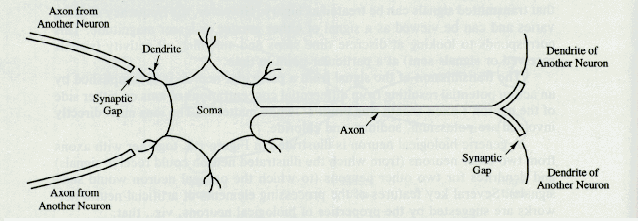
Before beginning an in depth discussion on artificial neural networks it is interesting and insightful to explore biological neural networks. A biological neural network is a collection of interconnected neurons, brain cells. Although biological neural networks exist in many places in the human body and in the bodies of other animals, the most interesting biological neural network is the human brain.
The brain consists of billions of highly interconnected brain cells known as neurons. Individually these neurons are very simple and can accomplish very little. However, when connected together, they form a powerful reasoning system. Each neuron has three basic parts: dendrites, a soma, and an axon. A neuron receives many input signals through its many dendrites. The signals then enter the soma of the neuron and are all summed together. If the summed signal is strong enough, the neuron fires; that is, it sends a signal out through its axon. The many neurons in the brain are connected together, axon to dendrite, to form a network of neurons or a biological neural network. One important thing to remember is that the signal on the axon of a neuron is not going to be exactly the same as a the signal on a dendrite of the neuron it is connected to. The signal is changed, generally strengthened or weakened, by the chemical process that transmits the signal across the synaptic gap.

The figure above should clarify the description given above.
The human brain would be useless if it could not get information from the outside world. Many of the signals that enter the brain come from neurons outside the brain, such as in the eyes, in the nose, or the nerves in our skin. Similarly, the brain needs to be able send information to the outside world. Many signals leave the brain through the body’s complex system of nerves and control all bodily functions.
It is also interesting to investigate how the human brain learns. Since there is very little difference between human neurons and neurons in other animals yet there is a great difference in intelligence, scientists believed the key to the learning process must lie outside the neuron. After years of research, scientists found that the answer lies in the connections between the neurons and the organization of the brain. Recall that a signal leaving one neuron changes before entering the next neuron. This change can be inhibitory, weakens the signal, or excitatory, strengthens the signal. As the brain learns, the amount the signal changes between any pair of connected neurons changes. For example, an initially excitatory synaptic gap could become inhibitory or vice-versa. The synaptic gap need not necessarily change from inhibitory to excitatory or vice-versa, the factor by which the signal changes, could vary also.
You may have noticed the similarities between the description of the biological neural network and the description of artificial neural networks given in the previous section. The model for artificial neural networks, in fact came from mathematically modelling the human brain. Nodes are the artificial analog of neurons and weights are the analog of the synaptic gaps. Although research into biological neural networks is very interesting, many of the more successful and modern neural networks lack biological plausibility. In other words, they don't model any biological function, and violate some of the restrictions that are present in the brain. To some researchers, biological plausibilty is very important. Fortuantely for others, that issue is secondary. The neural networks discussed on this site do not go into detail about biological plausibility. The following pages focus more on the mathematical basis for the learning rules.
![]()
Home Page ![]() Introduction
Introduction ![]() Biological Neural
Networks
Biological Neural
Networks ![]() McCulloch-Pitts Neuron
McCulloch-Pitts Neuron
Perceptron ![]() Adaline
Adaline ![]() Back Propagation
network
Back Propagation
network
References ![]() Research Paper
Research Paper ![]() Glossary
Glossary
![]() Beware: This
page is always under construction
Beware: This
page is always under construction
![]() Geocities
Geocities
![]() Geocities
Research Triangle
Geocities
Research Triangle